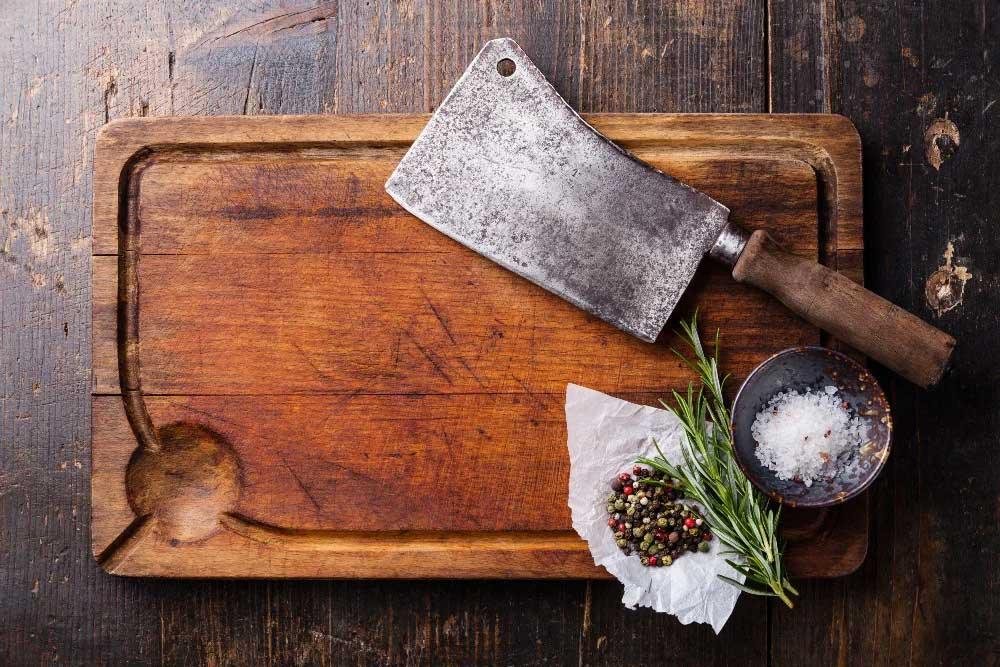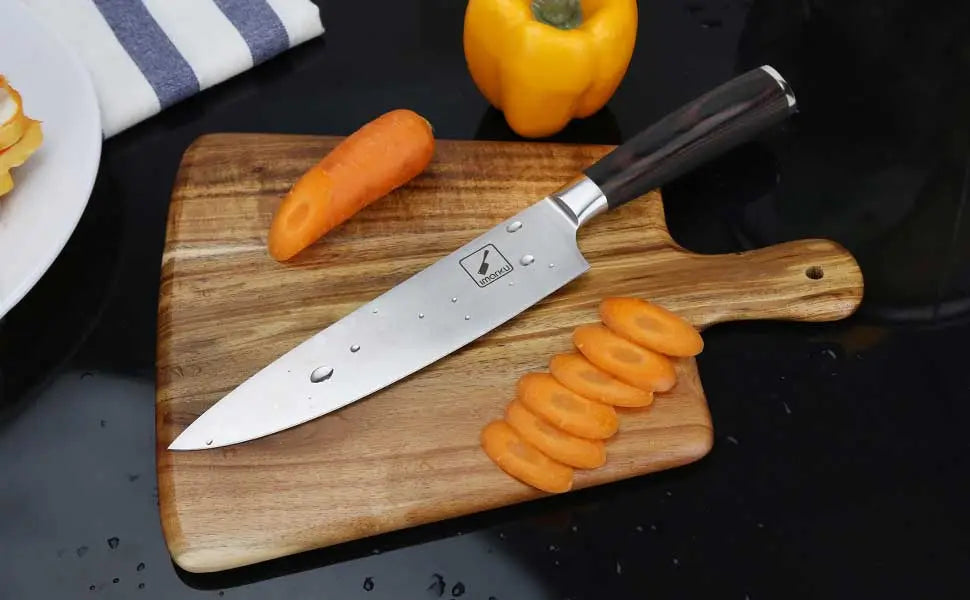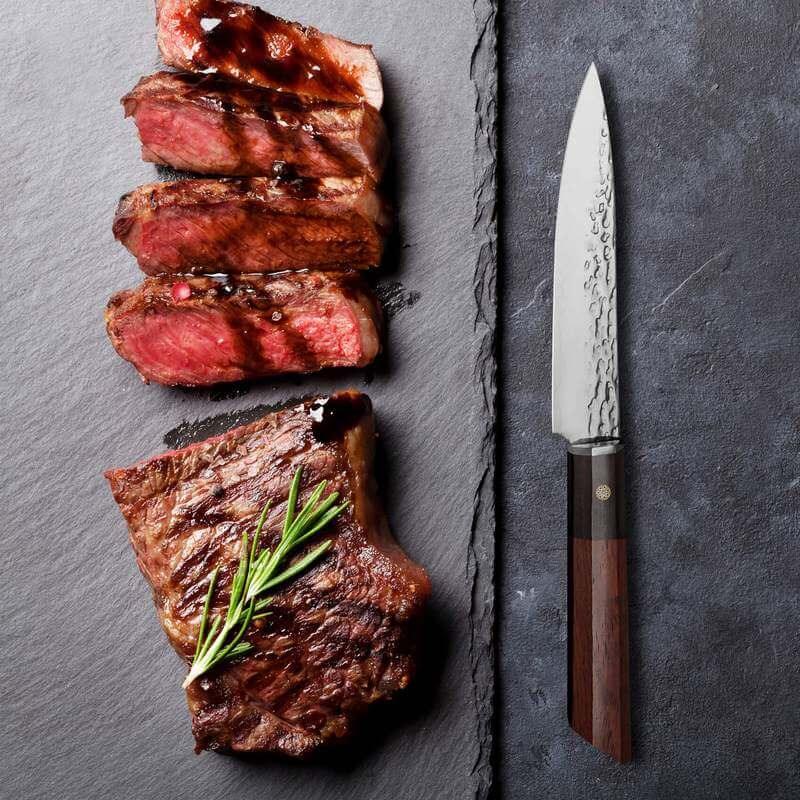TABLE OF CONTENTS
Let's be honest, you can survive without a proper chopping board. You can buy one of those cutting mats - and promptly replace them every year or so.
The food packaging offers easy cleanup, as well as a decent chance for you to damage the counters. Or you can pick up a random piece of wood or plastic and hope for the best.
Wood vs. Plastic chopping board, which one is better? Kitchen product designers spend a lot of time thinking this simple question. They must protect the kitchen counter, prevent cross-contamination and bacteria growth, preserve your knife's edge, etc.
But before we even get into those details, we have to go back to basics. Wood vs plastic cutting board. We are not even going to try and talk about bamboo or glass because those can seriously destroy your knife.
Both types have their strengths and weaknesses. Both are common in home and professional kitchens. But which one should be in yours?
Today we'll go over everything you wanted to know about wood and plastic cutting boards and we'll see which one is right for you. But first, let's check out our favorite models.
Our Recommendations

2 Sided Cutting Board With Handle | imarku
13.5 x 11.2 x 1 inch
Textured plastic.
Rubber edges.
This is one of the best cutting boards when prepping fruits and veggies. The textured surface prevents slipping and sliding, while the gentle slant forces the juices to pool at the bottom of the board. Both sides are usable and both have this same feature.
The top portion of the board features a small ginger grater, so you don't have to spend money on another unitasker. All edges are covered with rubber. It will keep the board in place when chopping your food.
The texture of the surface may seem like it will damage your knives, but there's no need to worry. It won't chip your knife at all.
Though the board can handle meat, we recommend using it only for handling produce.

2 Sided Wooden Cutting Boards | imarku
15.4 x 11.4 x 1 inch
Whole ebony wood.
Adjustable foot for easy handling and standing up.
We are in love with this cutting board for so many reasons. Let's start with the material. It's made from whole ebony wood which can handle quite a bit of use and abuse.
Then we have a trench that collects juices wither during meal prep or while carving a roast. The trenches lead to a circular indentation that can either store the excess juice or hold the jar of chutney when you put together a cheese board.
.Some of you will be delighted by a nifty little ruler at the bottom. But what makes this board truly outstanding is the rotating foot. When the board is not in use, it will help store it upright. Other times, it can be used to grip and maneuver the board.
We recommend seasoning this board before the first use and topping it up once a month after. It will pay you back with years of great service,
Pros and Cons of a Wooden Cutting board
Wood cutting boards are a favorite amongst chefs, but they are not perfect. It's always a good idea to invest in one since they are versatile and long-lasting.
Pros
- Gentle on your knife. A good wood cutting board is the best option for preserving a knife's edge. Not only does the knife stay sharp and the edge doesn't curl, but it's less likely to chip. If you are investing a lot into your knives, you have to get a wood cutting board.
- Long life span. Wood cutting boards can last decades. Of course, the lifespan depends on how often you use them and the aftercare. You can easily find wooden boards from the 18th century. They would need a bit of love and care, but they are still perfectly safe to use.
- Has multiple uses. A wooden board doesn't only have to stay in the kitchen. A smaller, easier-to-carry board can easily do double duty as a cheese board or a serving tray. After all, a cheese board is nothing else than a cutting board with a few specialty knives chucked in.
- Easy to maintain. Though there are a few strict maintenance rules that you have to follow, it's nothing time-consuming. The most amazing thing is that you can season it once a month with a little bit of oil, and the board will go back to looking almost pristine.
- Aesthetically pleasing. Wood boards are often used as decor as well. It will only enhance the look of your kitchen, as well as the table if you plan on using it as a cheese board. Once it stops looking good, you can upcycle it with ease. With a little bit of resin or acrylic paint, you can have something amazing.
Cons
- Sensitive to water and temperature changes. Both excess moisture and temperature fluctuations can make the wood warp. This will not only mess with the board's balance (which can lead to injury) but it will destroy your knife as well.
- Can be difficult to maneuver. The big boards can get heavy. If you have a disability or hand dexterity issue, that can be a problem. Plus, you could be stuck trying to find one that is well-made but not too heavy at the same time.
- Long downtime between uses. A wood board needs to dry properly between uses to prevent various beasties from growing on top of each other. That means that you can use one side, flip and use the other, and off to the wash. You can't quickly rinse the board so you can use it again while preparing the same meal.
Pros and Cons of a Plastic Cutting board
If you've ever used one of those super cheap plastic cutting boards, they may have left a bad taste in your mouth. As long as you get a better-made one, your opinion will change.
Pros
- Affordable. Plastic boards always cost less than wooden ones. Some designer models are a bit on the pricy side. However, you can reasonably expect to spend less on one of these. But, buyer beware. You do get what you pay for. The cheapest option will harm your knife and may even cause food contamination.
- Lightweight. Plastic cutting boards are a lot better suited to children and people with disabilities and dexterity issues. Not only are they lighter, but they are also easier to grasp since they are thinner.
- Space-saving. Since plastic boards tend to be thinner, they can usually fit into random nooks and crannies in your kitchen.
- Easy to clean and disinfect. Most plastic cutting boards are dishwashing machine safe. It's also easy to go from prepping chicken to cutting some fruits or veggies since you can wash the board and disinfect it in minutes.
- Easy to organize. You can also wash them by hand using a soft sponge. If you have to take an extra step, you can easily spritz the board with rubbing alcohol or another disinfectant.
Cons
- Will dull the knife's edge quicker. You will have to sharpen your knives more often with a plastic cutting board. High-density polyethylene is the best option and will give you the best results. However, the market is full of low-quality plastic that will not only dull the knife but damage it as well.
- Potential short life span. In a lot of cases, plastic cutting boards last only a year or so. Maybe even shorter than that. The second grooves and scars appear, it's time to replace the board. Whenever there's any damage on a plastic board, chances are there's a lot of bacteria lurking and collecting there.
- Not eco-friendly. It's plastic after all. In most cases, these boards were not made from recycled materials, nor do they end up recycled themselves.

Wood vs Plastic Cutting board - Which One Is Better for Knives?
In most cases, it's wood. The fibers in the wood split as the knife glides through which prevents the curling and chipping of the edge.
However, all wood cutting boards are not made equal. Teak, walnut, maple, beech, oak, pecan, and cherry wood make the best boards. Avoid juniper pine, cedar, redwood spruce, and other softwoods. They may be easy on the knife, but they are completely unhygienic.
Composite cutting boards are also knife-safe, but you have to check what type of wood they are made from to be sure they are food safe as well.
Bamboo is not very knife-friendly at all. It's very stiff and it will cause the knife edge to curl. It's still a little bit better than glass which will destroy your knives.
Plastic is somewhere in between. You will have to hone and sharpen your knives more often, but it won't destroy them.
What Type of Cutting board Is More Versatile?
This depends on your needs.
Wood is better for different cutting and chopping techniques. In fact, if you have great knife skills and you can chop an onion in a flash, wood is a better option. It will keep the blade sharp no matter how fast you go.
Wood is also a lot more attractive and stays that way for years with a little TLC. This means that you can use the board as a cheese board, a trivet, a serving tray, etc.
However, plastic wins when we consider how often we can wash it during meal prep. While a wood board needs time to dry before you can use it again, plastic is ready to go as long as you can wipe it down.

What Type of Cutting board Is More Hygienic?
It depends. Both plastic and wooden cutting board are made from different materials. Some of those materials are better at resisting bacteria than others.
Overall, wooden cutting boards are more hygienic, as long as it's hardwood like maple or teak. They trap the liquid and kill off the bacteria as the board dries.
Cheap plastic cutting boards are terrible because the knife will leave grooves during each use. These grooves easily become a perfect breeding place for bacteria.
However, high-density polyethylene is a lot safer. Not only because it is a lot more resistant, but also because you can wash it. Since you can only rinse wood, you have to rely on the quality of the material for all bacteria-killing action. However, you can throw most plastic cutting boards into the dishwasher, submerge them in boiling water, spray them with disinfectant, etc.
Which One Is Better Value, Wood vs Plastic Cutting board?
Though a wood board always costs more than a plastic one, they have a lower cost per use. They last for years, or even decades. Even when they start looking a bit bad, they can be restored with some wood seasoning.
Plastic cutting boards have to be replaced once they start looking worn out. As we've just discussed, all those cuts and grooves are not only cosmetic problems. As they age, they start trapping more bacteria.
You can expect solid five years from a good quality plastic cutting board. Still, check every year or so to make sure you are not contaminating your kitchen.
Conclusion
Ideally, you should own both types of cutting boards. However, if you're getting only one right now, it should be a wooden board. Wooden boards last longer, are better for your knife and are a lot more versatile.
Wood cutting boards are best for rough and tough jobs. Think quick chopping or butchering. Since they can absorb a lot of shock, they can handle a butcher's cleaver landing repeatedly, as well as rapid slicing and dicing.
You can always get an affordable cutting mat to replace a full-sized plastic cutting board in the meantime. When you're ready to commit, invest in a board made from good quality food-safe plastic that won't dull the knife.
Plastic cutting boards are ideal for preventing cross-contamination since they can be washed and disinfected easily. They are also a better option for small kitchens and people with hand dexterity issues and disabilities.






















Leave a comment
All comments are moderated before being published.
This site is protected by hCaptcha and the hCaptcha Privacy Policy and Terms of Service apply.